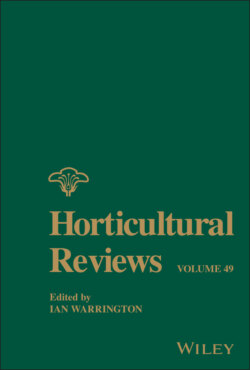Читать книгу Horticultural Reviews, Volume 49 - Группа авторов - Страница 20
VII. GENETICS AND BREEDING A. Ploidy and Genome Size
ОглавлениеGenome size and ploidy have been well studied in Hydrangea. Although there is some speculation that the ancestral base chromosome number is n = 9 (Cerbah et al. 2001), the current base chromosome number in Hydrangea is n = 18, with most species (including H. quercifolia) having 2n = 2x = 36 chromosomes (Van Laere et al. 2008). Exceptions to this include H. aspera and H. involucrata, which have 2n = 34 and 2n = 30, respectively (Mortreau et al. 2010). Another exception to this is H. platyarguta Y. De Smet & Granados, which has 2n = 2x = 24 chromosomes (Qiu et al. 2009). Cerbah et al. (2001) found that the North and South American hydrangeas had the smallest genome sizes with H. quercifolia being the smallest of all species investigated (1.95 pg 2C DNA; 1.9 Gb). Zonneveld (2004) reported similar findings, noting H. quercifolia with the smallest genome at 2.17 pg 2C DNA (2.1 Gb). However, H. seemannii has been reported to have a similar genome size at 2.09 pg (2.1 Gb) (Cerbah et al. 2001).
Although most Hydrangea are diploid, higher ploidy levels are not uncommon in the genus. Triploidy has been determined to arise from unreduced gamete production in H. macrophylla and triploid plants were noted to have an increased stem thickness and a decreased number of flowers (Jones et al. 2007; Alexander 2017). While, no naturally occurring tetraploid H. macrophylla have been documented, induced polyploidy has recently been reported in H. macrophylla (Deans et al., 2021) and H. febrifuga (syn. Dichroa febrifuga), which is the one of the most closely related taxa to H. macrophylla, has been determined to exhibit diploid, tetraploid, and hexaploid cytotypes (Rinehart et al. 2010). H. paniculata has also been documented in the diploid, triploid, tetraploid, pentaploid, and hexaploid states with tetraploidy being the most common (Cerbah et al. 2001; Funamoto and Ogawa 2002; Zonneveld 2004; Beck and Ranney 2014). Oakleaf hydrangea has thus far only been documented in the diploid state; however, morphological traits could potentially be enhanced by induced polyploidy. Polyploidy can be induced using antimitotic chemicals or by the strategic use of unreduced gametes, although no H. quercifolia genotypes have been reported to produce 2n gametes.
